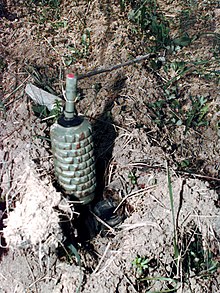PMR-2
| PMR-2 | |
|---|---|
|
|
|
| General Information | |
| Designation: | PMR-2 |
| Type: | Anti-personnel mine |
| Country of origin: | Yugoslavia |
| Technical specifications | |
| Combat weight: | 1.7 kilograms |
| Charge: | 100 grams of TNT |
| Diameter: | 66 millimeters |
| Height: | 140 millimeters |
| Detonator: | Draft fuse |
| Lists on the subject | |
The PMR-2 ( P rotupješačka M ina R asprskavajuća - 2 to German as: anti-personnel Split Schedule 2) is an in the former Yugoslavia prepared Stock Mine , from the kind of anti-personnel mines , the extensively during the Yugoslav Wars was used. It is considered a replica of the Russian stick mine family POMZ from the Second World War.
description
The cylindrical body of the mine is made of cast steel, the outside is asymmetrically pre-fragmented (9 rows of fragments). A black hard rubber ring is screwed into the top as a fuse holder. On the underside there is the opening for receiving the explosive device (100 grams TNT) and the wooden stake.
How it works and detonator
The mines are delivered in wooden boxes with eight mine bodies, eight wooden stakes, eight detonators, eight rolls of trigger wire and a detonator container with six UPMR-2A detonators and two UPMR-2AS detonators per box. The two types of UPMR detonators are the standard PMR-2 models, but other detonator models such as B. those of the Russian MUV series or the Czech RO-1 can be used.
After the wooden stake has been inserted into the ground, the explosive device is placed on top and the mine body is placed on top. The mine body also serves as a fragmentation jacket. Then, the igniter is screwed onto the mine body and the trigger wire ( Tripwire ) designed. The trigger wire is attached to the detonator's cotter pin, which holds a pretensioned firing pin in the rearward position. The trigger wire can be stretched taut ( tension wire ) or laid out loosely on the floor ( trip wire ).
By pulling on this trigger wire, the safety pin is pulled out of the detonator, which releases the preloaded firing pin and can strike the detonator below. The detonator initiates the explosive device, the explosion of which tears up the pre-fragmented mine body, creating a fragmentation effect.
When using the UPMR-2AS detonator, a flare set is fired at the same time when it is triggered in order to signal the exact position of an approaching enemy in the dark.
eviction
Even years or decades after the end of the war, the mines still pose a considerable threat to the civilian population and international clearing teams in the former Yugoslavia. Trigger wires and the mines themselves have grown into the vegetation in many places and are often difficult to locate, and the detonator can be in one unpredictable condition if z. B. the cotter pin is no longer completely in the igniter, or the cotter pin is completely missing and the firing pin and / or the spring has just jammed or rusted.
An attempt is therefore made to lift the mine body from the wooden stake with a mine snare or mine claw so that the explosive device can fall out. In a similar way, the wooden stake itself is removed from the ground, as it can be protected by resume safety devices (e.g. unlocked hand grenades or booby traps with pull detonators), as has been documented in rare cases.

